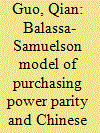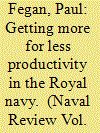| Srl | Item |
| 1 |
ID:
095936


|
|
|
|
|
| Publication |
2010.
|
| Summary/Abstract |
Our principal purpose here is to assess the extent to which both the official and black market exchange rates for the Chinese economy exhibit compatibility with the Balassa-Samuelson model over the period from 1985 to 2006. We employ annual measures of inflation and industry input on an aggregated, disaggregated and sector basis, all of which have been especially constructed for this study. Both the time series and panel cointegration tests applied to this data are generally inconsistent with the prediction of the Balassa-Samuelson model that the tradable goods sector is compatible with purchasing power parity. However, our analysis also shows that other predictions of the Balassa-Samuelson model - most notably that there will be a strong long-run relationship between the real exchange rate and the relative productivity differential between China and the U.S. - does hold up for the Chinese economy. Moreover, the black market exchange rate appears to be more consistent with the predictions of the Balassa-Samuelson model than the official exchange rate.
|
|
|
|
|
|
|
|
|
|
|
|
|
|
|
|
| 2 |
ID:
150138


|
|
|
| 3 |
ID:
110507


|
|
|
|
|
| Publication |
2011.
|
| Summary/Abstract |
Since China's transition to a market economy, the labour productivity growth has been dramatically rapid, in particular since 1994. This speeding up has been accompanied by the reverse of the exchange rate policy of China, which has strongly depreciated its currency before 1994, and then either appreciated or stabilized it. The theoretical arguments suggesting several kinds of real exchange rate impact on labour productivity are developed. An econometric model is then proposed and estimated, using panel data for the twenty-nine Chinese provinces and for the period from 1986 to 2007. The econometric results show that the appreciation of the real exchange rate had a favourable effect on the labour productivity growth, leading to a kind of virtuous circle: the real appreciation of the currency boosts the growth of labour productivity while, according to the Balassa-Samuelson effect, productivity growth tends to push up the real appreciation. Moreover, this favourable effect is stronger in inland provinces than in coastal provinces, contributing to a minimizing of the gap between inland and coastal provinces.
|
|
|
|
|
|
|
|
|
|
|
|
|
|
|
|
| 4 |
ID:
165366


|
|
|
|
|
| Summary/Abstract |
During the last decade, Bangladesh economy grew consistently over 6 per cent annually; however, growth rate in the agriculture sector declined. Labour away from agriculture is evident; it is also evident real wages in the agriculture sector are rising. This could be an indication that Bangladesh is moving to a different stage of economic development. This article investigates whether Bangladesh is approaching a stage of economic development where marginal productivity of labour equals its price, called the Lewis turning point (LTP). We find that the reallocation of labour away from agriculture has had a positive but insignificant impact on economic growth in Bangladesh. We also find that the surplus agricultural labour has not fully been absorbed by the economy. Therefore, we conclude Bangladesh has yet to reach the LTP and suggest initiating policies (e.g., job creation in the service sector) that might speed up the country’s movement to the LTP.
|
|
|
|
|
|
|
|
|
|
|
|
|
|
|
|
| 5 |
ID:
139484


|
|
|
|
|
| Summary/Abstract |
This study analyzes the impact of spiralling growth in usage of contractual labour, in the context of stringent pro-worker labour regulations, on industrial labour productivity and employment generation. We obtain a quantitative measure of ‘stringency of labour regulations’ by applying majority rule on three different measures used in the literature. The results show that average labour productivity increases with the increase in the ratio of permanent workers to contractual workers, unless the industries are not operating in states having rigid/pro-worker labour regulations—which implies a negative impact of contractualization on labour productivity. Besides, the results show that the rigid/pro-worker labour regulations have negative impact on employment generation; it is especially discernible in labour-intensive industries.
|
|
|
|
|
|
|
|
|
|
|
|
|
|
|
|
| 6 |
ID:
029931


|
|
|
|
|
| Edition |
New series No. 75.
|
| Publication |
Geneva, International Labour Office Publication., 1969.
|
| Description |
172p.
|
| Series |
ILO
|
|
|
|
|
|
|
|
|
|
|
|
Copies: C:1/I:0,R:0,Q:0
Circulation
| Accession# | Call# | Current Location | Status | Policy | Location |
| 005420 | 331.118/INT 005420 | Main | On Shelf | General | |
|
|
|
|
| 7 |
ID:
167571


|
|
|
|
|
| Summary/Abstract |
Indian manufacturing industries have experienced the major effects of economic reforms. Since the effect of any policy is ultimately transferred to workers, this article is an attempt to determine the extent to which labour productivity and wages are inter-related in manufacturing industries. The study uses state-level panel data of manufacturing industries and empirically tests the relevance of marginal productivity theory of wages and efficiency wage theory. After confirming the stationarity of the series, various empirical tests such as cointegration, vector error correction mechanism and Granger causality are applied to check the long-run equilibrium relationship between wage growth and productivity growth.
|
|
|
|
|
|
|
|
|
|
|
|
|
|
|
|